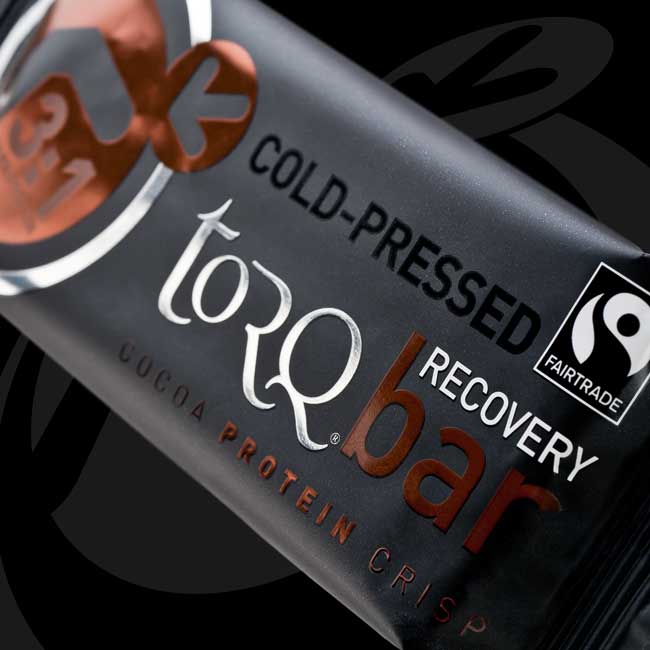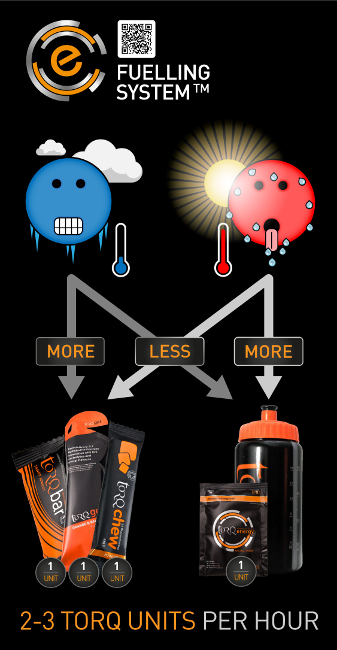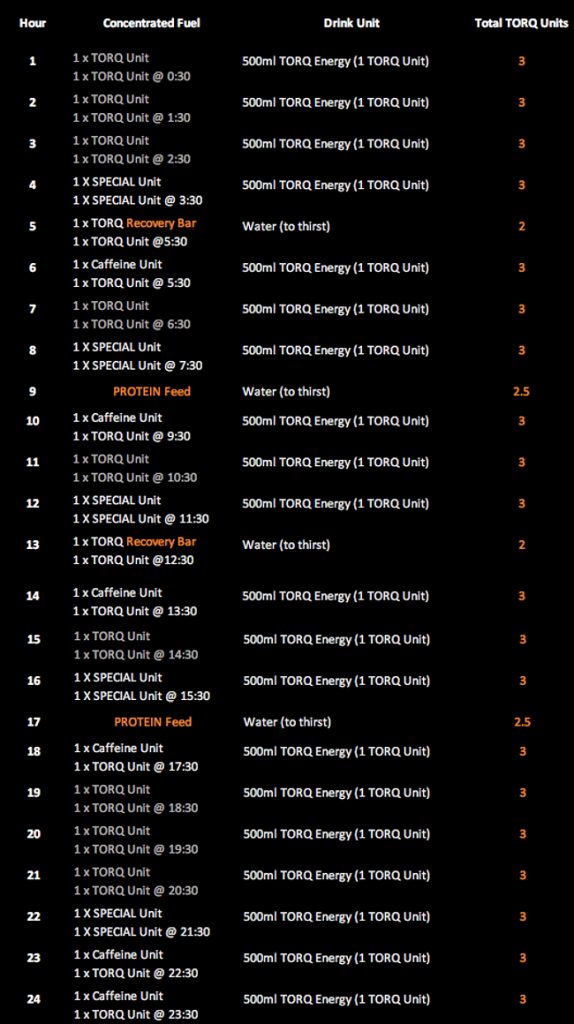We’ve discussed the fundamentals in the previous section, but let’s look at this real life example and what we’ve suggested Mark should actually do for this race. Mark is experienced at consuming 90 grams of carbohydrate (3 TORQ Units) per hour and this is vital to establish at the outset. The gut is a trainable organ and you can’t simply start throwing large amounts of carbohydrate at it and expect it to do the job without some rehearsal time. Get used to taking carbohydrate calories on during training and if you are going for the optimal 90g per hour strategy, make sure you’ve had a dry run in anger over a long distance so that you’re confident you can handle it. 60g (2 TORQ Units) of 2:1 formulations will work well with everyone, because it’s 40% below the intestine’s absorption threshold, but pushing to the higher levels needs to be planned.
So, our plan with Mark was to stick to the TORQ Fuelling System and 90g (3 TORQ Units) per hour from the moment he started, consuming his first 30g (1 TORQ Unit) on the start line 1 minute before he set off. This will gave his muscles some exogenous carbohydrate to burn right from the gun, immediately sparing his stored endogenous carbohydrate. The plan was then for him to continue following the TORQ Fuelling System at 3 TORQ Units per hour.
Mark planned two scheduled stops at 8 hours and 16 hours where (as well as having a good stretch) he would take on a 25g protein feed and have a choice of a TORQ Recovery Drink, TORQ SNAQ 3:1 Cinnamon & Raisin Breakfast or TORQ SNAQ 3:1 Smoked Tomato Pasta Meal. All will essentially do the same job, but after such a large amount of riding it would be difficult for Mark to predict what he would be feeling like eating. All of these choices will supply similar nutritionals, so he just needed to choose what he fancied at the time. Once consumed, Mark would consume water only for the following hour and wouldn’t consume any TORQ Fuelling System products unless his body started asking for them. This is because with his 25g protein feed, he’d also get 75g of carbohydrate and he needed to give his body chance to absorb this. If your personal feed choice were to be a lean ham sandwich for instance, you would want to make sure that you got 20-25g protein from it, but your body would start asking for fuelling products sooner, because the carbohydrate in the bread would be significantly lower than 75g. Mark is vegetarian, hence the choices we opted for.

In addition to these 2 scheduled stops, Mark would be handed up either a TORQ Recovery Bar or a small TORQ Recovery Drink, each containing around 15g of protein at 4, 12 and 20 hours. The 4 hour protein feed was likely to be a Recovery Bar and at 12 and 20 hours, a Recovery Drink, because it would be easier to consume. Again after the protein feed, Mark would consume plain water again, but this time for just 30 minutes and then move back onto the TORQ Fuelling System.
So, with the TORQ Fuelling System, which products would Mark use? Hopefully by this point in the article, you understand how the system works, but just as a reminder, the diagram below illustrates how Mark’s choices would be affected by environmental conditions and perspiration rates.

Therefore, the approach we decided to follow was that if conditions were cooler (below 25 degrees C), Mark would be consuming around 500ml TORQ Energy Drink per hour and consuming a concentrated TORQ Fuelling Unit every 30 minutes to provide his 3 TORQ Units per hour. If temperatures moved above 25 degrees, he would continue to consume a concentrated TORQ Fuelling Unit every 30 minutes, but use TORQ Hypotonic Drink instead. TORQ Hypotonic contains half the carbohydrate of TORQ Energy Drink, but the same concentration of electrolytes and this means that he could consume 1 litre per hour for hydration purposes, but still only be consuming 1 TORQ Unit. In summary, 500ml of TORQ Energy Drink = 1 TORQ Unit and 1,000ml of TORQ Hypotonic = 1 TORQ Unit.
It could have been possible that temperatures would result in high perspiration rates during the day and then reduce at night, so Mark’s team would need to move him from TORQ Hypotonic to TORQ Energy as the sun goes down. There are other ways to go about this and Mark could have consumed 1 litre of TORQ Energy per hour (2 units) along with 1 concentrated TORQ Unit to have exactly the same effect, it’s just that we consider this strategy of a concentrated fuelling unit every half an hour without fail easier to manage and better psychologically for Mark – the more decisions that were made prior to the competition, the more he would be able to concentrate on the task at hand.
Mark would be using a variety of flavours in the TORQ drink range, which would include TORQ Energy Vanilla, a product we designed specifically for the rigours of ultra-endurance events. This drink tastes like watery ice cream and is almost savoury on the palate – a revelation when all else you have been consuming has been sweet and fruity.
With regard to the concentrated TORQ Fuelling Units, would Mark be eating gels, bars or chews? The answer is that he would have a mixture of everything to create variety. All of the fuelling units will do the same job, so it actually wouldn’t matter which ones he consumed, but we worked out a nice little system to help with the psychological demands he will be enduring. We asked Mark which were his favourite products and although he was very easy to please and said he likes them all, we singled some out that we considered to be ‘special’ and we scheduled these for ‘special hours’ to help him keep focus and turn his grimace into a little smile. So during hours 4, 8, 12, 16 and 22 he would be having Cherry Bakewell gels and/or Organic Mango bars. If he felt like having 2 gels, he’d leave the Mango bar, but every 4 hours or so would be his finest hour.
Also, he loves the Caramel Latte gels too and as these have the added benefit of caffeine delivery, this gel will be the first fuelling product he would have after a protein feed, which would complete his fuelling cycle for hours 6, 10, 14 and 18. He would also take one at the start of hours 23 and 24 to bring him home. This would give him a total of 6 caffeine injections over the 24-hour period.
All other fuelling would be via a random mixture of TORQ’s great flavours. The table below shows what we were aiming to achieve through this feeding strategy. NOTE: For clarification, a protein feed after 4 hours of riding would take place at the start of hour 5.







